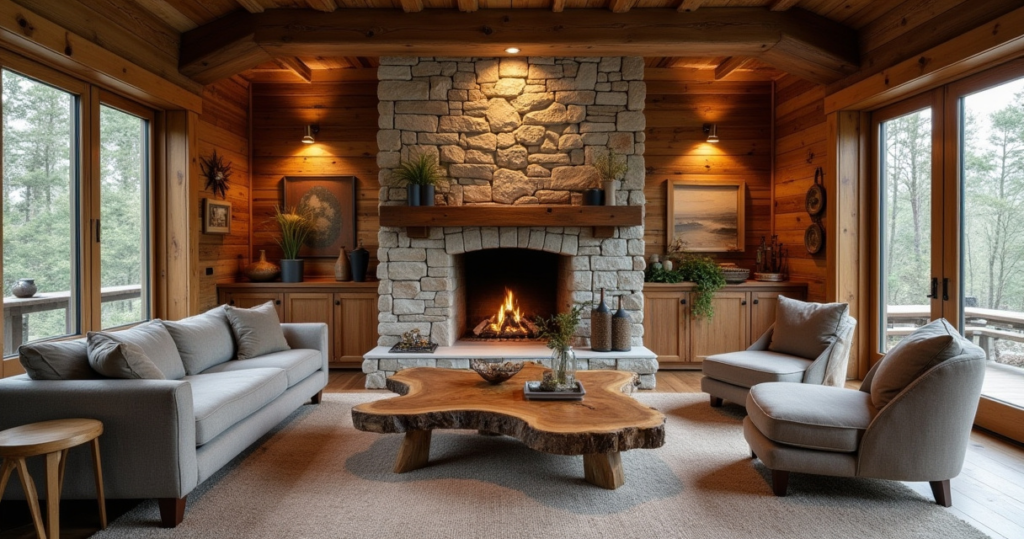Can we have a quiet word about “rustic”? There’s a particular pet peeve of mine that I see splashed all over the internet, a sort of sanitised, mass-produced version of rustic that’s all synthetic barnwood and signs that say “Farmhouse.” It feels less like a home and more like a stage set for a television show filmed in a Los Angeles suburb. It’s clean. It’s tidy. And frankly, it’s devoid of soul.
The real heart of a rustic interior, the kind you find in a windswept Scottish lodge or a honey-stoned cottage in the Cotswolds, isn’t about a specific look. It’s about a feeling. It’s the feeling of coming in from the rain, kicking off your muddy boots, and sinking into a sofa that’s seen better decades but offers the best comfort of your life. It’s about texture, history, and a certain unapologetic sturdiness. It celebrates imperfection because that’s where the stories are. So, if you want to create a space that feels genuinely layered, warm, and real, put that catalogue down. Let’s talk about how it’s properly done.
Establishing Your Rustic Foundation
Before you even think about scatter cushions, you must get the bones of the room right. This isn’t about trends; it’s about creating an authentic backdrop that will endure for years. We’re talking about colour, texture, and the kind of fundamental comfort that invites you to put your feet up.
1. Adopt an Earth-Toned Palette for Cozy Warmth
Forget sterile whites or модish greys. A proper rustic room is steeped in the colours of the landscape it belongs to. Think of the deep, peaty browns of the moors, the soft, mossy greens of a forest floor after it rains, the hazy blues of a British sky, and the warm, Farrow & Ball-esque sludgy neutrals that look as if they’ve been mixed with a bit of earth. These colours don’t just look good; they have a psychological effect, wrapping the room in a gentle, reassuring embrace.
The real trick is to avoid a flat, monochromatic scheme. Everyone else will tell you to pick a safe beige and stick to it. That’s a recipe for boredom. The secret is layering multiple, often muddy, tones. I once had a client who was terrified of a deep, plummy brown for his library. I persuaded him to paint just the walls behind the bookshelves. It instantly made the room feel a hundred years older and a thousand times more inviting. The books and objects popped, and the room felt like a warm hug. It’s about creating depth, not just colour.
With your palette decided, it’s time to bring in the foundational textures that give the style its name.
2. Integrate Authentic Raw Wood and Stone Textures
This is non-negotiable. Rustic design is the celebration of raw materials. Exposed timber beams, a great slab of stone for a hearth, or rough, unvarnished floorboards are the very soul of the look. These materials connect a house to the land it’s built on. They have history and integrity. I’ve seen London flats transformed by simply exposing an old brick wall, its imperfections telling a story that no perfectly plastered surface ever could.
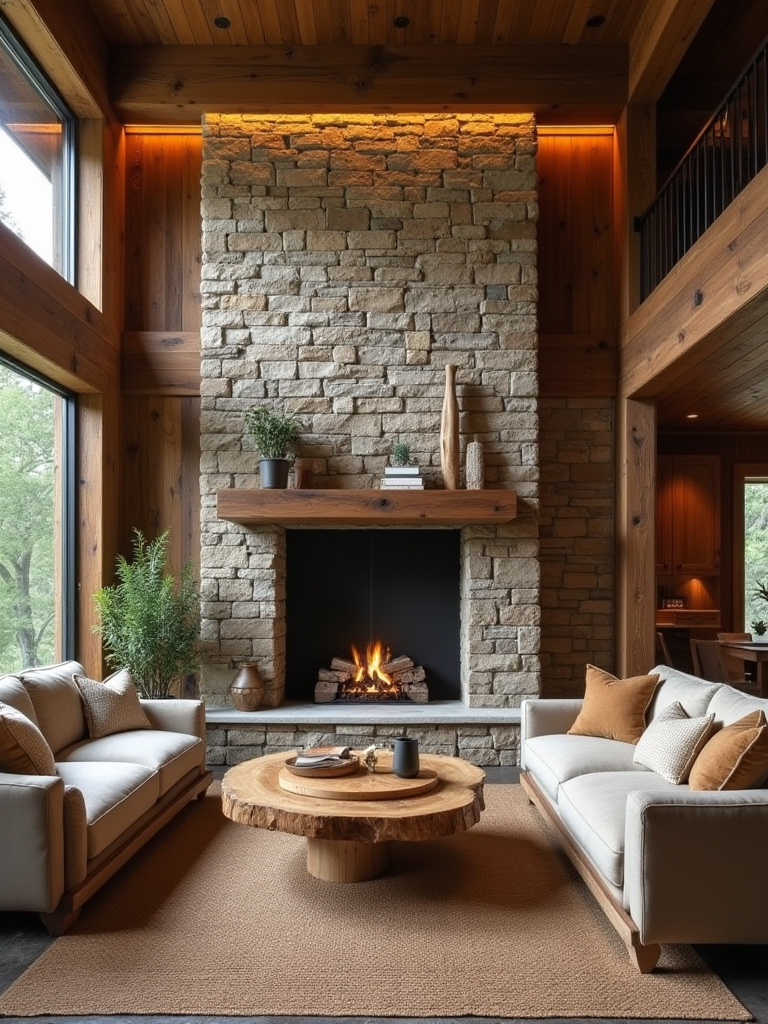
The common pitfall is to either fake it with dreadful plastic-y veneers or to polish the life out of the real thing. Please, resist the urge to sand and varnish an old oak beam until it gleams. Its knots, its cracks, its slightly uneven surface—that’s the entire point. My shortcut? When you think a piece of wood or stone is “finished,” step back and see if you’ve erased its character. If it looks too perfect, you’ve gone too far. Embrace the rugged.
Now that the room has its architectural soul, we must find somewhere comfortable to sit.
3. Choose Substantial, Comfort-Driven Seating Solutions
I cannot stress this enough: your sofa is the heart of the room. A rustic living room is not the place for a delicate, leggy settee you’re afraid to sit on. You need something substantial, something you can truly sink into with a book and a cup of tea. Think of the classic Howard & Sons sofa, a veritable British institution—deep, squishy, and utterly unapologetic in its pursuit of comfort. Its frame should be solid, and its presence should ground the entire space.

I once watched a client agonize between a terribly chic Italian sofa and a rumpled, oversized English roll-arm. She chose the Italian one. A year later, she called me to say no one ever sat on it; they all perched. We sold it and bought the comfortable one. The lesson? A rustic living room is for living in. Prioritise genuine, bottom-sinking comfort over fleeting style every single time. It’s the anchor of hospitality.
This magnificent beast of a sofa will, of course, need a worthy companion.
4. Feature Reclaimed or Distressed Wood Coffee Tables
The coffee table is your room’s central gathering spot, so it needs to have a bit of heft and a story to tell. A piece made from reclaimed wood—perhaps from an old factory floor or a seaside pier—brings an immediate sense of history into the room. These pieces are not just furniture; they are artefacts. The dings, the old nail holes, the watermarks… they all add to its narrative.
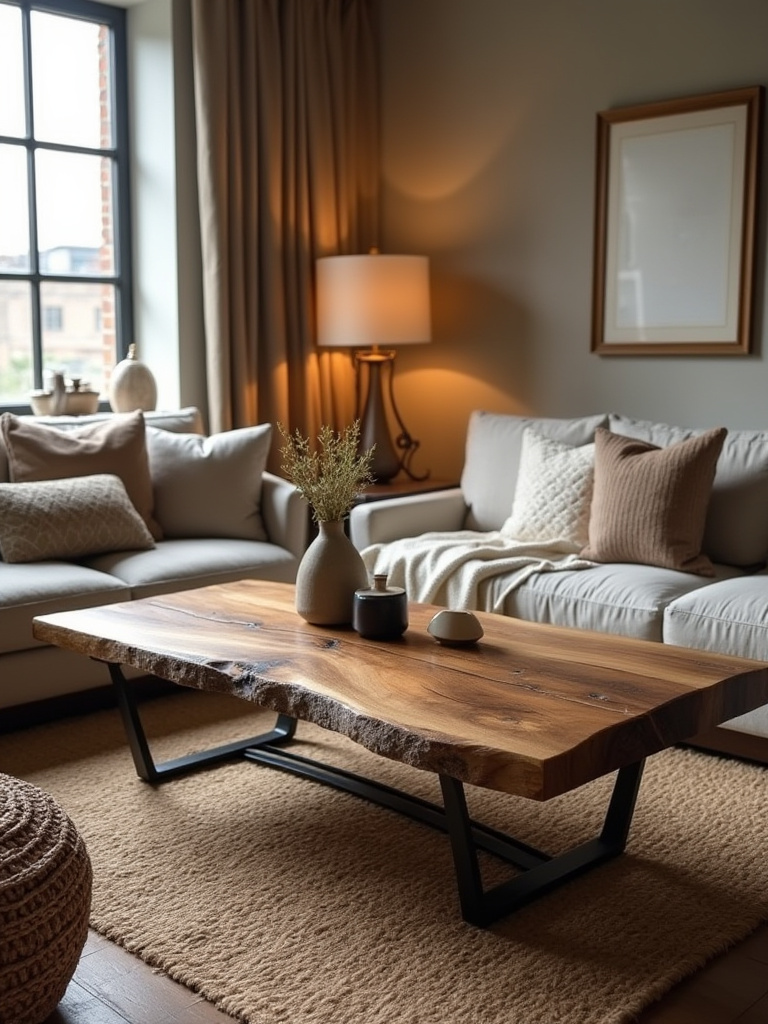
Here’s the thing everyone gets wrong: they buy “distressed” furniture that has been artificially aged in a factory with a bit of chain and some strategically applied paint. It looks utterly fraudulent. A truly beautiful rustic piece earns its patina over time. The shortcut is to frequent reclamation yards and antique markets. Look for pieces that have character baked in, not painted on. A solid, honest lump of wood in the centre of your room will ground everything around it.
Now, let’s address the floor and tie everything together.
5. Select Durable Natural Fiber Rugs to Ground Your Space
A bare wood or stone floor is beautiful, but a large, textured rug is what truly defines a seating area and adds a crucial layer of warmth. While sisal and jute are popular, I find that for a truly British rustic feel, nothing beats wool. It’s a workhorse. It’s naturally stain-resistant, feels wonderful underfoot, and has an earthy, honest quality that synthetics can never replicate. It stands up to muddy dogs, spilled red wine, and generations of use.
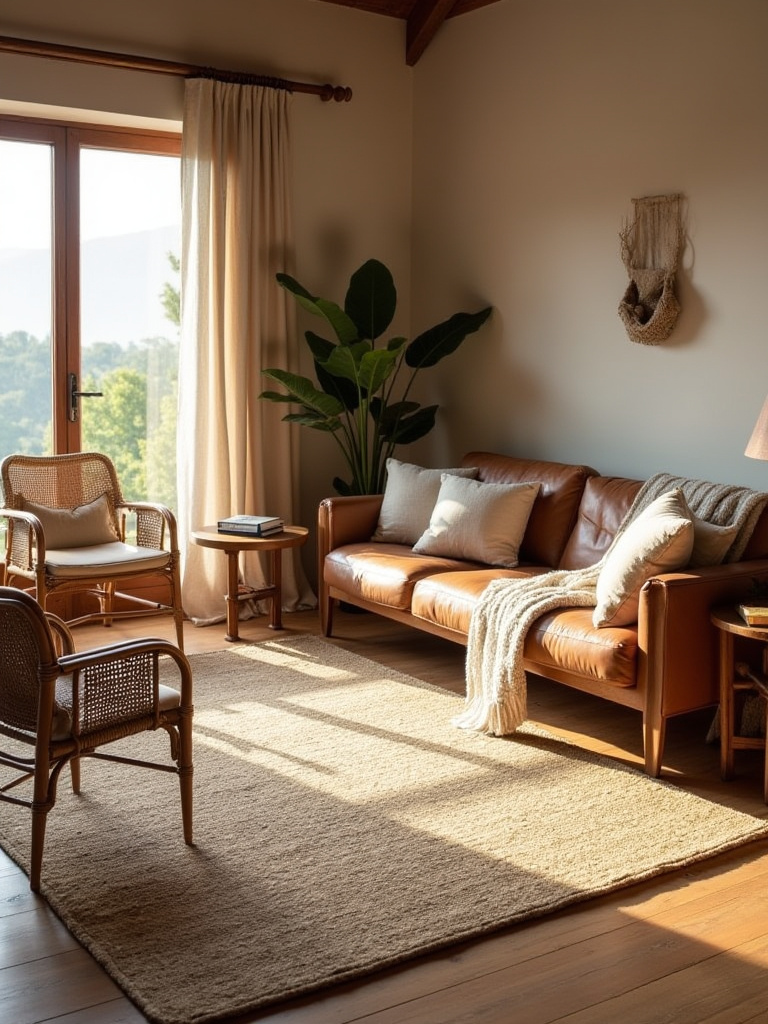
The biggest mistake I see is the postage-stamp-sized rug. It’s when a small rug floats pathetically in the middle of the floor, with no furniture touching it. It makes the whole room feel disconnected. Your rug needs to be large enough for at least the front legs of your sofa and all armchairs to rest comfortably upon it. It physically and visually pulls the conversational area together. If in doubt, always go a size up.
With the core elements grounded, it’s time to add the softer layers that create that irresistible feeling of home.
Layering for Warmth and Ambiance
This is where the magic happens. A room with a good foundation is handsome, but a well-layered room is intoxicating. It’s about adding the tactile and atmospheric elements that make a space feel not just decorated, but cherished.
6. Drape Luxurious Faux Fur and Wool Throws
In a country where draughts are a national pastime, a good throw is not a mere accessory; it’s a survival tool. And in a rustic setting, it’s an opportunity for glorious texture. Think of a thick, chunky-knit wool blanket thrown over the arm of a chair or a decadent faux fur draped across the end of a sofa. They are a visual shorthand for “come, get cosy.”
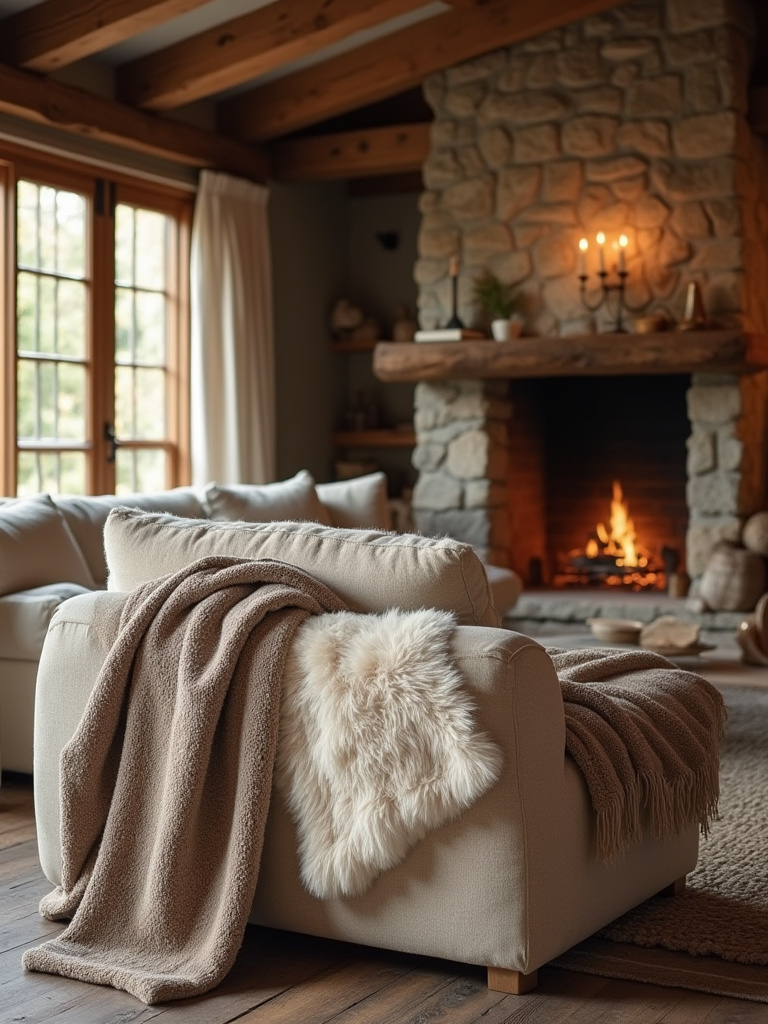
The common mistake is to fold them into sharp, hotel-like rectangles. Utterly joyless. A throw should look like it was just used. Let it puddle, let it drape, let it look inviting and slightly messy. My rule is that a throw should be so appealing you can’t help but reach out and touch it. It’s about tactile pleasure, not military precision.
As you get cosy under your throw, you’ll need the right light to read by.
7. Introduce Warm, Dimmable Lighting for Evening Charm
There is a singular horror in British domestic life known as the “big light”—that one harsh, central ceiling fixture that illuminates a room with all the charm of a doctor’s surgery. A rustic room demands the opposite. It needs pools of warm, gentle light. This means lamps. Table lamps, floor lamps, reading lamps. And every single one of them should be on a dimmer switch.
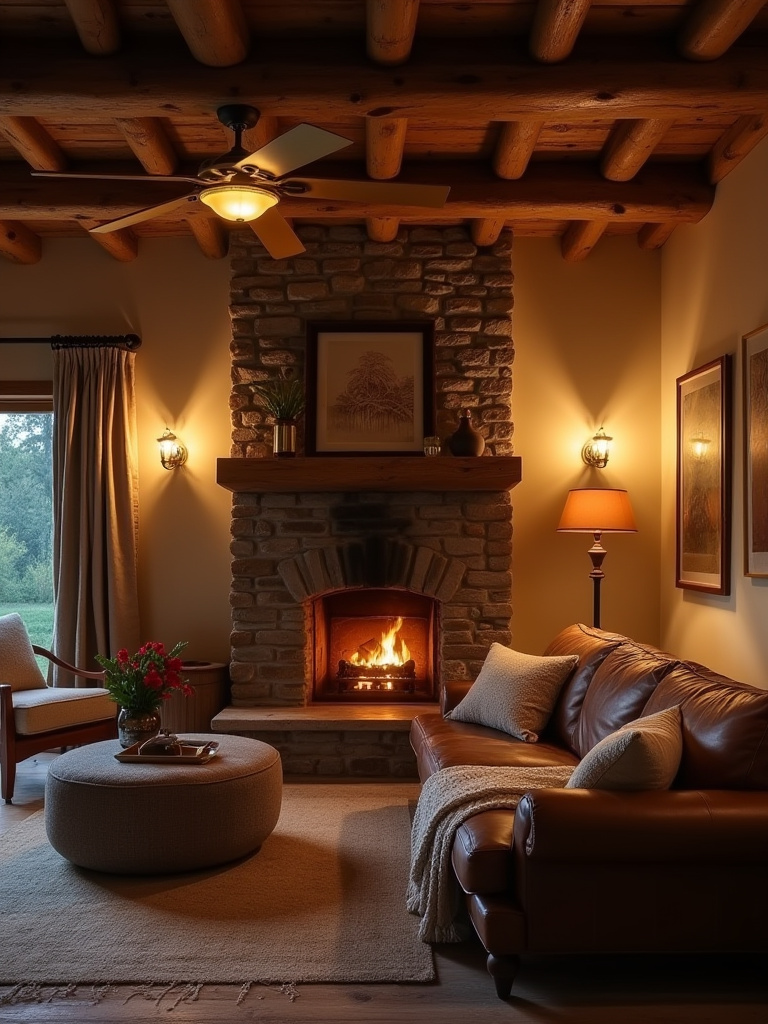
This is the single most effective and surprisingly affordable change you can make. The ability to dial down the lights as the evening draws in transforms a room instantly. Look for bulbs with a low Kelvin temperature (around 2200K-2700K) to get that lovely, golden, almost candlelight glow. It makes wood look warmer, colours richer, and human faces prettier. It is, quite simply, the secret to atmosphere.
Now, let’s bring a bit of the outside world in.
8. Integrate Lush Greenery with Robust Indoor Plants
The British obsession with gardening doesn’t stop at the back door. Bringing plants inside softens the hard edges of wood and stone and breathes life into a room. This isn’t the place for delicate, high-maintenance orchids. You want something with a bit of presence and structure—a sturdy Fiddle Leaf Fig in a corner, a trailing ivy tumbling from a bookshelf, or a pot of hardy ferns.
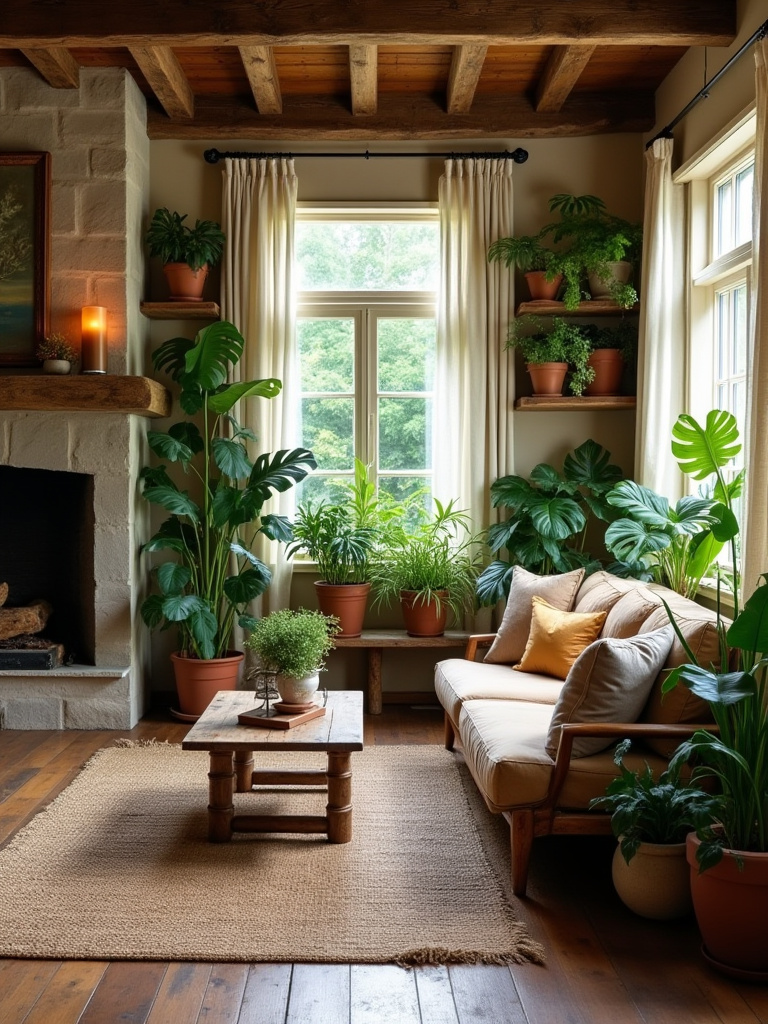
The key is to choose planters that enhance the rustic feel. Forget glossy plastic. Think terracotta, aged zinc, concrete, or even a simple woven basket. I find that grouping a few pots of varying sizes together creates a more natural, less staged look than scattering single plants around the room. It’s like creating a tiny, wild corner of your own indoor garden.
With the softness of nature established, it’s time for a touch of iron.
9. Accent with Wrought Iron Fixtures and Decor Pieces
A rustic room benefits immensely from a touch of something dark, solid, and forged. Wrought iron, with its matte black finish and handcrafted feel, provides the perfect punctuation mark. Think of it in curtain poles, a simple chandelier, or a set of fireplace tools. It offers a handsome contrast to the warmth of wood and the softness of textiles.
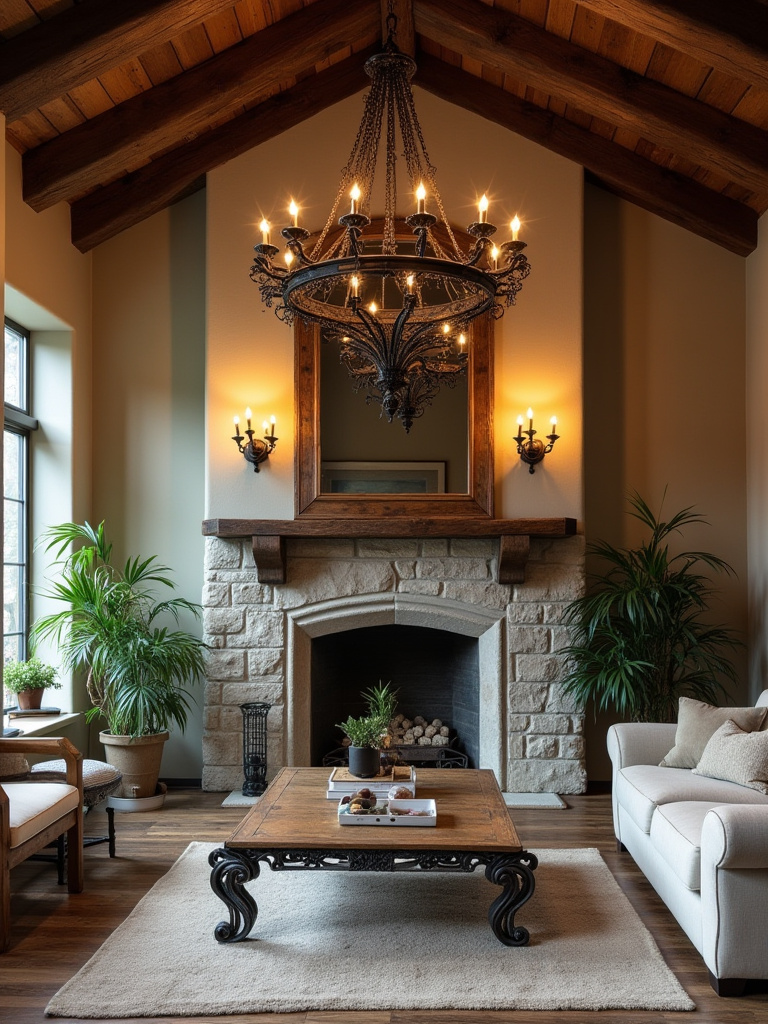
The great risk here is overdoing it. A little goes a very long way. Too much, and your living room starts to feel like a medieval-themed pub. My advice is to think of wrought iron like a bold em-dash in a sentence—a strong, structural element that provides definition and a slight industrial edge without dominating the entire story. It should feel anchoring, not oppressive.
This brings us back to our seating, and how we dress it.
10. Upholster Seating in Natural, Durable Fabrics Like Leather
The materials you sit on matter immensely. Leather is a classic choice for a reason: it’s incredibly durable and, crucially, it gets better with age. A good quality leather armchair or sofa will develop a magnificent patina over the years, a map of all the life lived on it. It’s the very definition of rustic elegance. But don’t stop there; think about other honest, hard-wearing fabrics. A robust Harris Tweed, a heavy linen, or even a sturdy wool boucle.
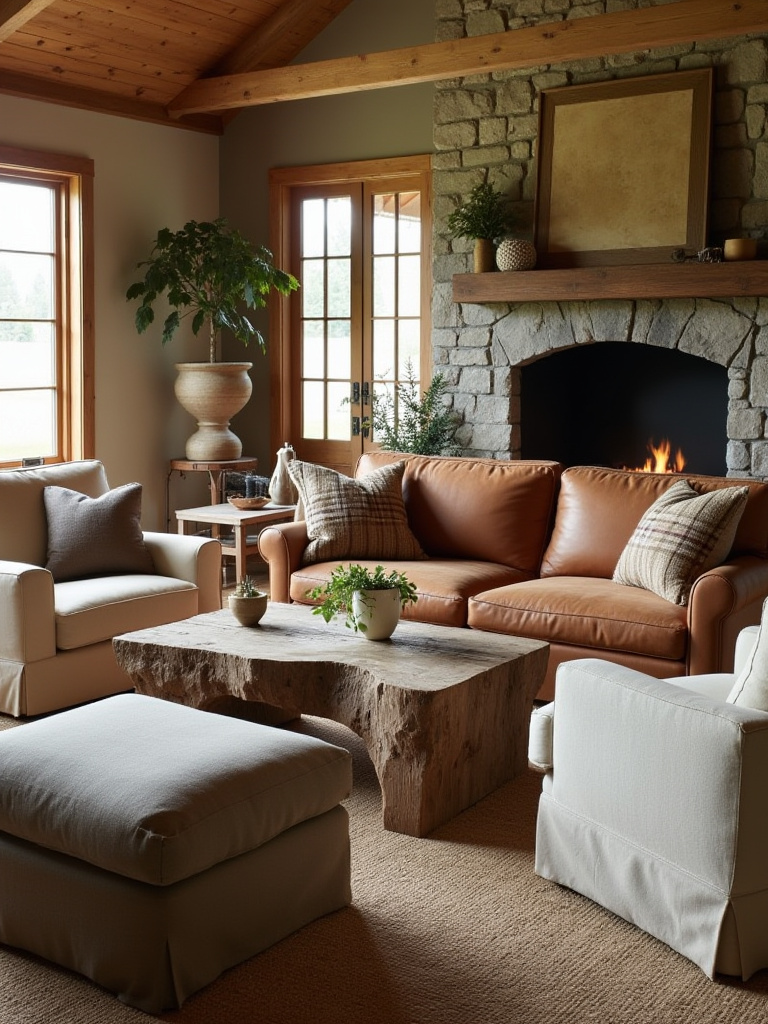
So many people are tempted by synthetic lookalikes to save a few pounds. Don’t. They will pill, they will sag, and they will never, ever develop that lovely, lived-in character. They just look tired. Investing in quality, natural upholstery is one of the smartest things you can do. It’s the difference between a piece of furniture that lasts a lifetime and one that you’ll be replacing in five years.
Personalizing with Distinctive Character
A room with a solid foundation and lovely layers is good. A room that also reflects you is great. This is where you move beyond a “style” and create a “home,” infusing the space with pieces that tell your personal story.
11. Curate Unique Vintage Finds and Heirloom Antiques
This is the absolute joy of it. Anyone can buy a new sofa, but finding that perfect, slightly battered 19th-century pine chest at a car boot sale? That’s a triumph. A rustic room is the perfect home for these found objects and treasured heirlooms. A grandfather’s old writing desk, a collection of mismatched vintage landscape paintings, a tarnished silver tray—these things have soul.
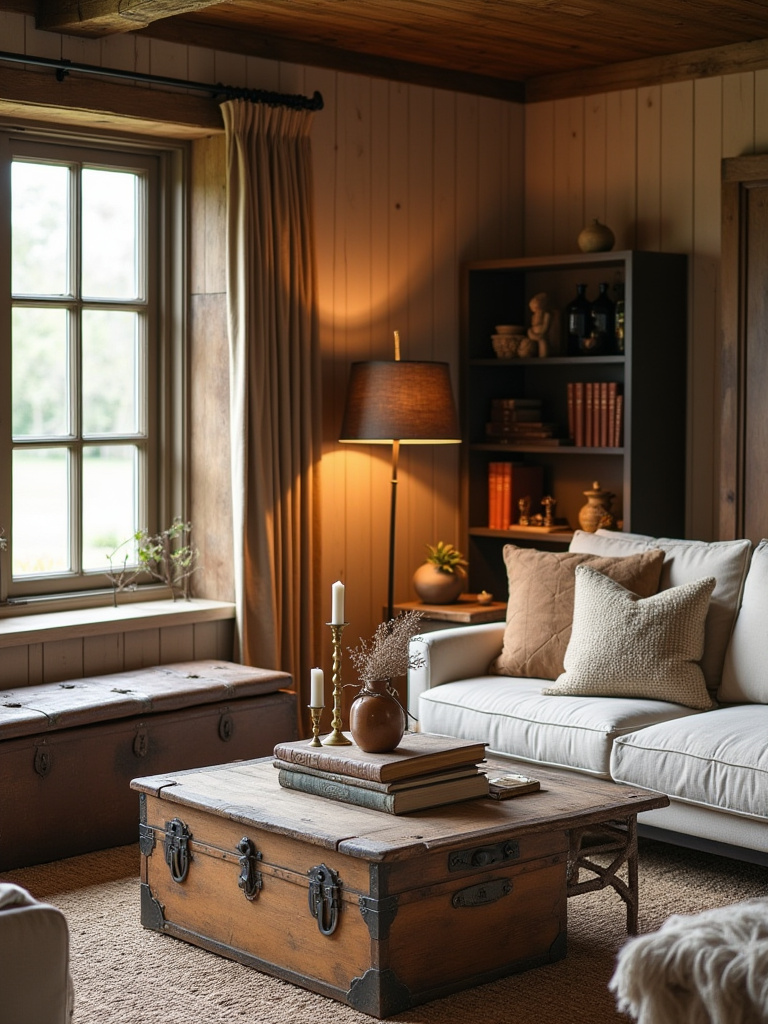
“Every room needs a touch of antiquity, just as it needs a sense of the future.” — David Hicks
The BS to avoid is what I call “curated clutter.” Don’t just fill your space with old tat for the sake of it. The key is to be selective. Choose pieces that speak to you, that have a function, or that simply make you happy when you look at them. One magnificent antique armoire is worth a hundred dusty little trinkets. It’s about personal history, not a museum display.
And as you collect these treasures, you’ll need somewhere to store the less-than-treasure-like realities of life.
12. Utilize Woven Baskets for Elegant, Concealed Storage
Life is messy. There are remote controls, magazines, children’s toys, and all the other bits and bobs of daily existence. The rustic solution is the humble woven basket. In materials like seagrass, willow, or rattan, baskets offer a beautifully textured and discreet way to hide the clutter. A large one by the fireplace can hold kindling; another next to the sofa can swallow up newspapers and blankets.
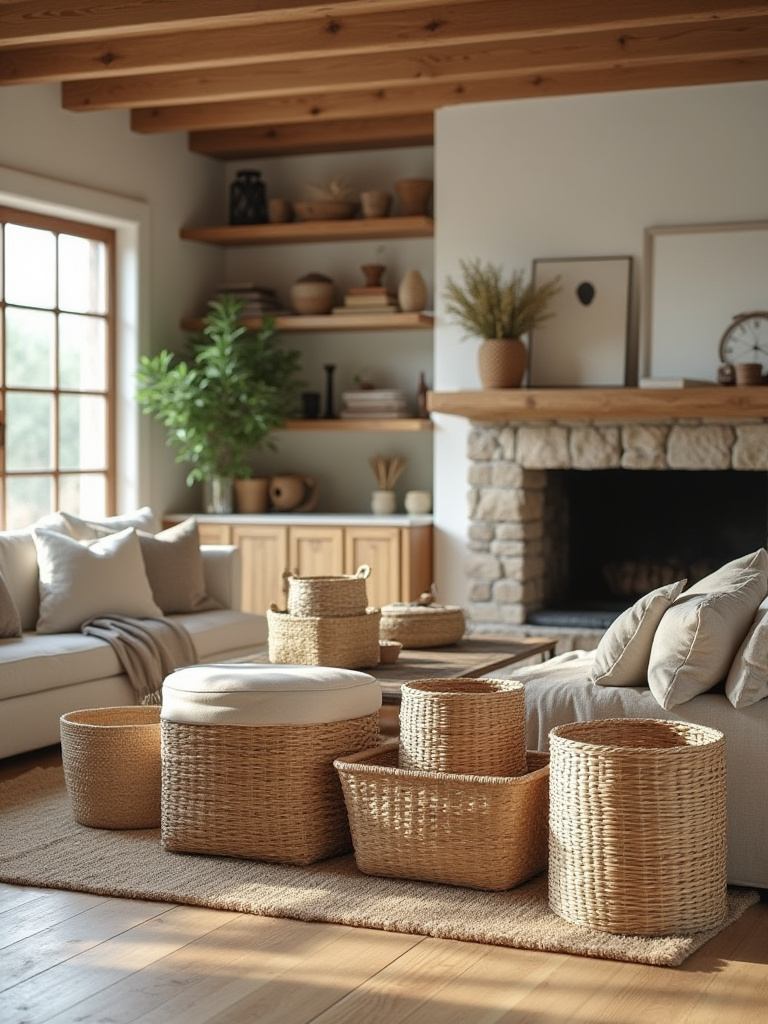
Their beauty lies in their practicality. They are the antithesis of slick, built-in storage. They feel organic, relaxed, and effortlessly stylish. The shortcut is to buy them in sets of two or three varying sizes. Grouping them gives them more presence and purpose than a single, lonely basket. It’s the most elegant mess-management system there is.
Now for a touch of architectural panache.
13. Create Visual Interest with Paneling or Barnwood Accents
Adding texture to your walls is a wonderfully effective way to build character. This could be classic tongue-and-groove paneling painted in a soft, earthy colour for a cosy, cabin-like feel, or a more dramatic accent wall of reclaimed barnwood. It adds a layer of architectural interest that paint alone simply cannot achieve, and in old British homes, it often had the practical purpose of adding a layer of insulation.
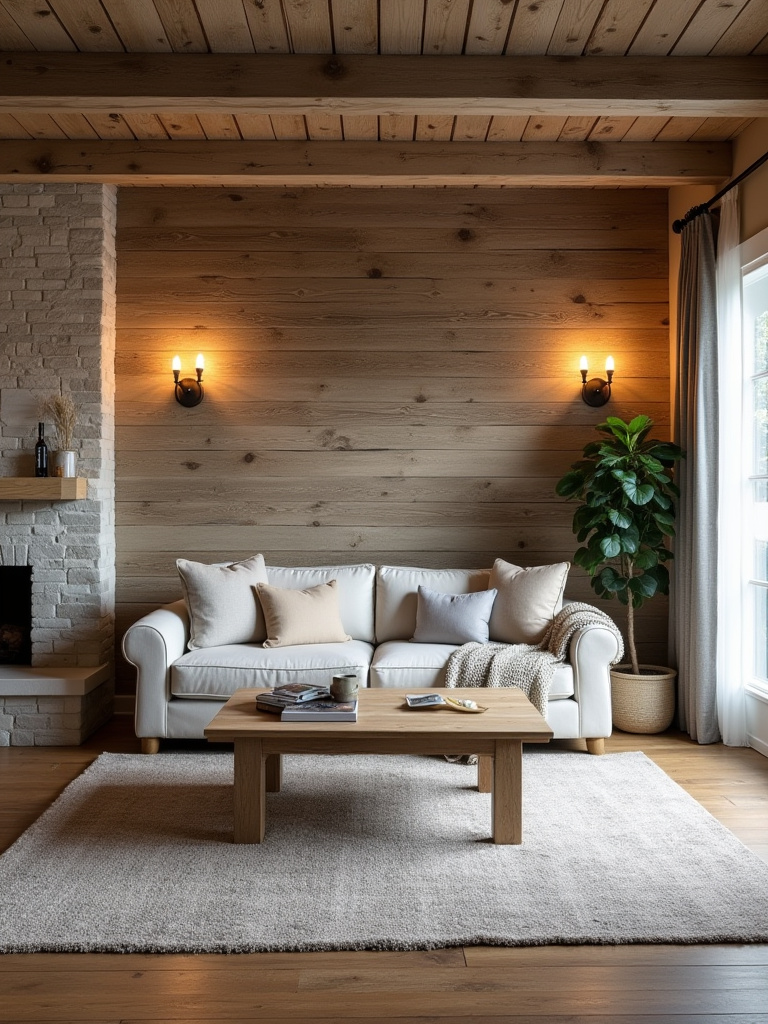
A word of caution: this is not an all-or-nothing affair. Paneling an entire room can sometimes feel a bit heavy and oppressive, especially if the ceilings are low. Often, the most powerful application is on a single feature wall—behind the sofa or framing a fireplace. It creates a focal point, drawing the eye and adding immense depth and warmth without overwhelming the space.
For another architectural statement, consider how you move between rooms.
14. Install a Sliding Barn Door for Authentic Architectural Charm
While sliding barn doors feel quintessentially American farmhouse, their practicality is universal, and they have historical precedent in British agricultural buildings and workshops. They are brilliant space-savers, eliminating the “swing arc” of a conventional door, which can be a godsend in a small cottage. More than that, they are a piece of functional sculpture.
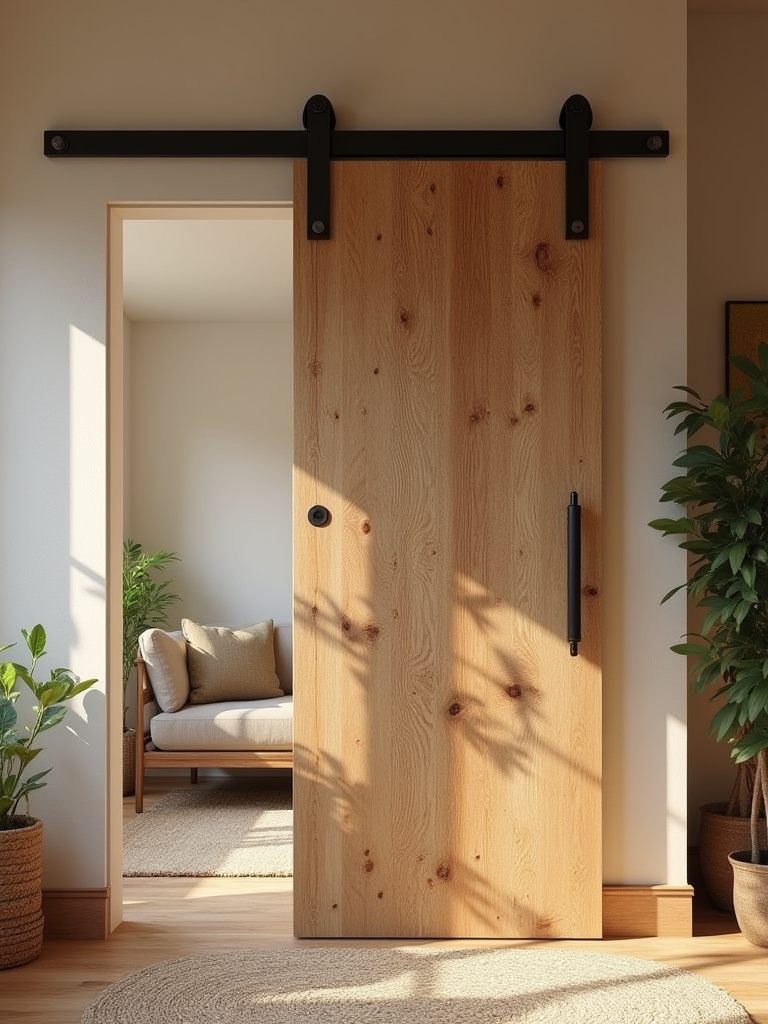
The key is to ensure the hardware is as handsome as the door itself. A sturdy, black iron track and rollers become part of the aesthetic. I worked on a converted oast house in Kent where we used a massive sliding door made from the building’s original timber to separate the living area from a study. It was a spectacular feature that honoured the building’s history while serving a modern purpose.
With your architectural features in place, it’s time to dress the walls.
15. Showcase Nature-Inspired Artwork and Wildlife Prints
The art in a rustic room should echo its connection to the outdoors. This is the perfect place for landscape paintings, whether moody oil paintings of the sea or gentle watercolours of the countryside. Botanical illustrations, sketches of birds, or even old maps add a touch of scholarly charm. Think less of a formal gallery and more of a personal collection gathered over time.
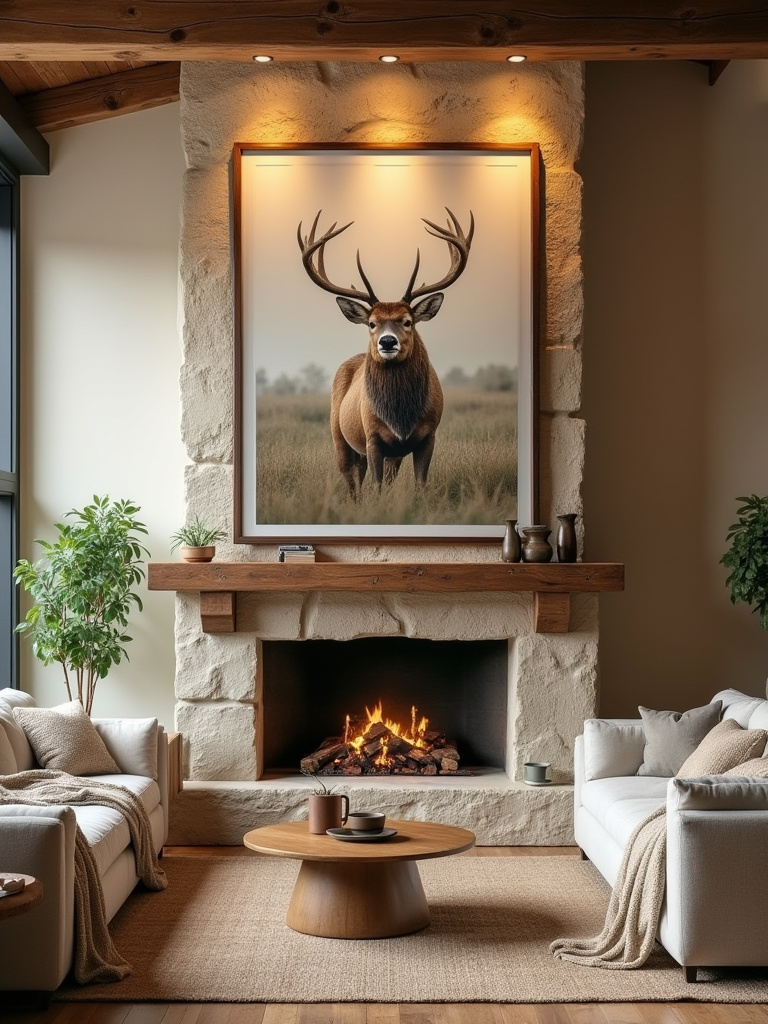
What you want to avoid is anything too generic or mass-produced. One genuine, albeit modest, piece of art from a local artist is worth more than a dozen canvas prints from a home goods store. The framing is also key. Simple, solid wood frames—or even unframed canvases—feel more authentic than ornate, gilded ones. Let the art be a window to the natural world you’re celebrating indoors.
Refining Details and Finishing Touches
God, as they say, is in the details. Once the big pieces are in place, it’s the final five per cent that elevates a room from “nice” to “spectacular.” This is about honing the details and adding layers of sophistication.
16. Master the Art of Patina for Authentic Aged Appeal
Patina is the gentle sheen that develops on surfaces over time through use and exposure. It’s the soft glow on an old wooden bannister, the subtle discolouration of aged brass, the worn softness of a leather armchair. It is, in short, the visible evidence of history. You cannot buy authentic patina; you must earn it, or be lucky enough to inherit it.
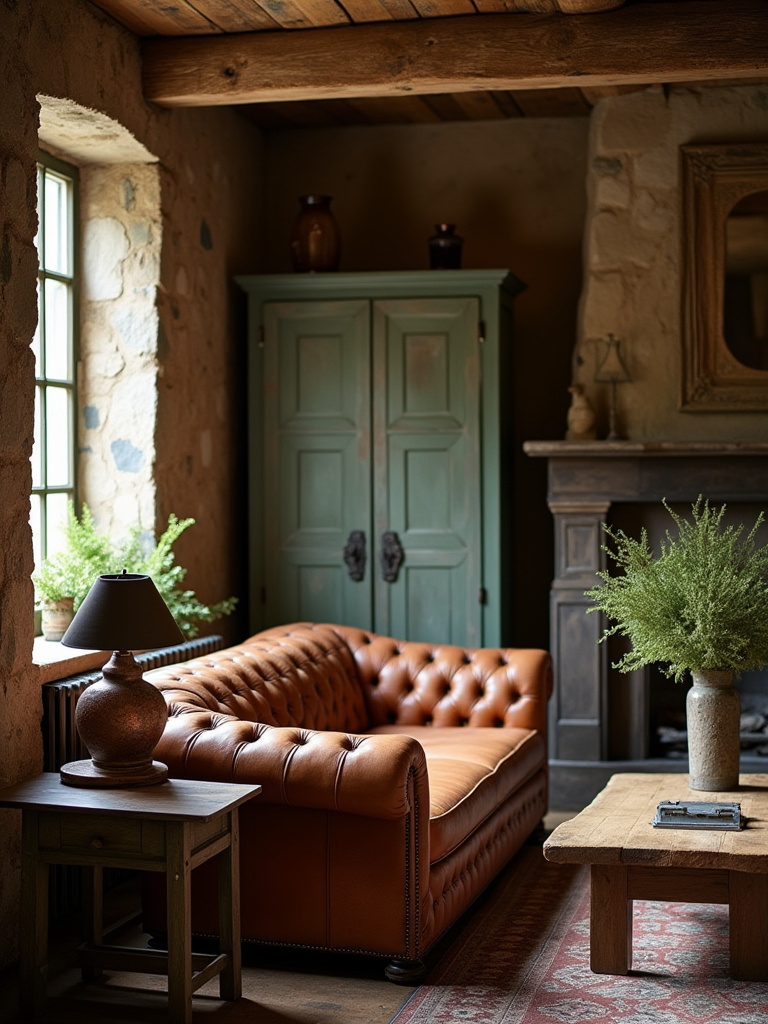
I once had to physically stop a client from taking Brasso to a pair of gorgeous, 100-year-old brass candlesticks. He saw tarnish; I saw character. The temptation in our modern world is to make everything shiny and new. Resist it. Allowing materials to age gracefully is the most sophisticated design choice you can make. It lends a sense of permanence and soul that is the very essence of rustic charm.
And speaking of new things, let’s discuss how to mix them in.
17. Blend Modern Pieces for a Sophisticated, Updated Rustic Vibe
This is where things get really interesting. A room that is purely rustic can sometimes feel a little… heavy. A bit like a theme park. The secret to a truly chic, contemporary rustic look is to create a dialogue between old and new. Juxtapose that hefty reclaimed wood table with sleek, modern dining chairs. Hang a bold piece of abstract art above a traditional stone fireplace. Place a minimalist, clean-lined floor lamp next to a squishy, traditional sofa.
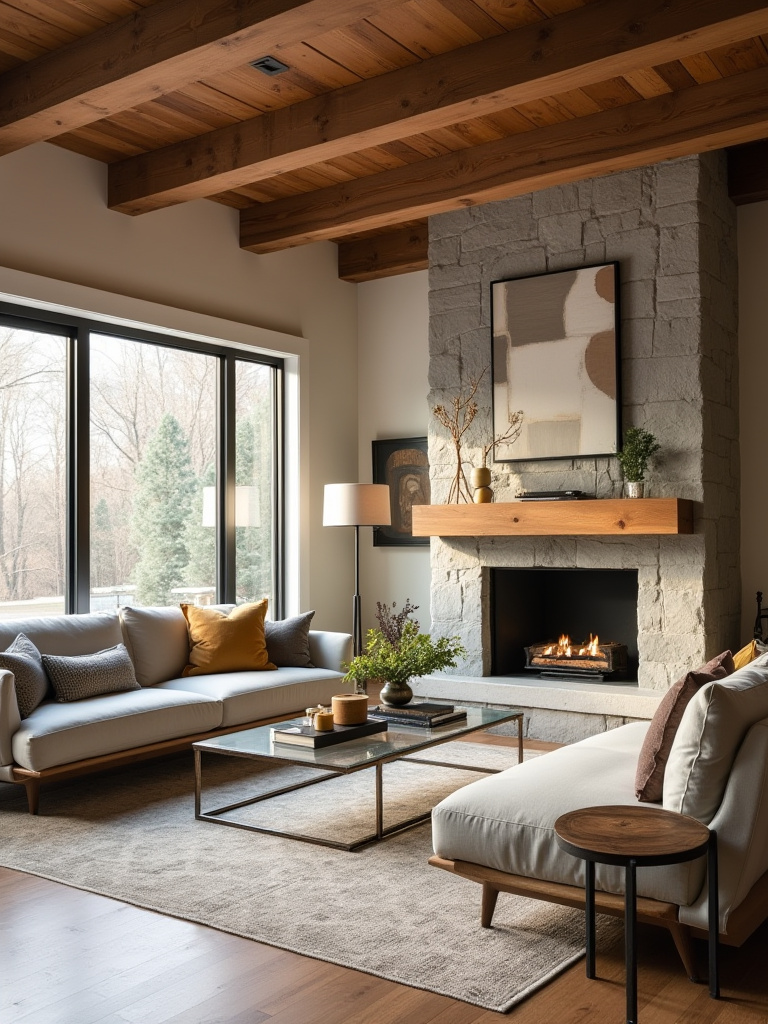
The key is contrast. The clean lines of the modern pieces make the texture and character of the rustic elements pop, and vice-versa. It stops the room from feeling like a museum and instead makes it feel current, curated, and dynamic. It shows confidence. The BS is just randomly throwing things together; the art is in ensuring the pieces, though different, speak to each other in terms of scale, colour, or form.
Next, let’s think about how people will move and talk in this beautiful space.
18. Optimize Furniture Layout for Intimate, Welcoming Zones
The worst sin in furniture arrangement is pushing everything back against the walls, creating a vast, empty no-man’s-land in the centre of the room. It feels like a village hall waiting for a dance. A living room should encourage intimacy and conversation. You must pull your furniture away from the walls and group it into functional, welcoming zones.
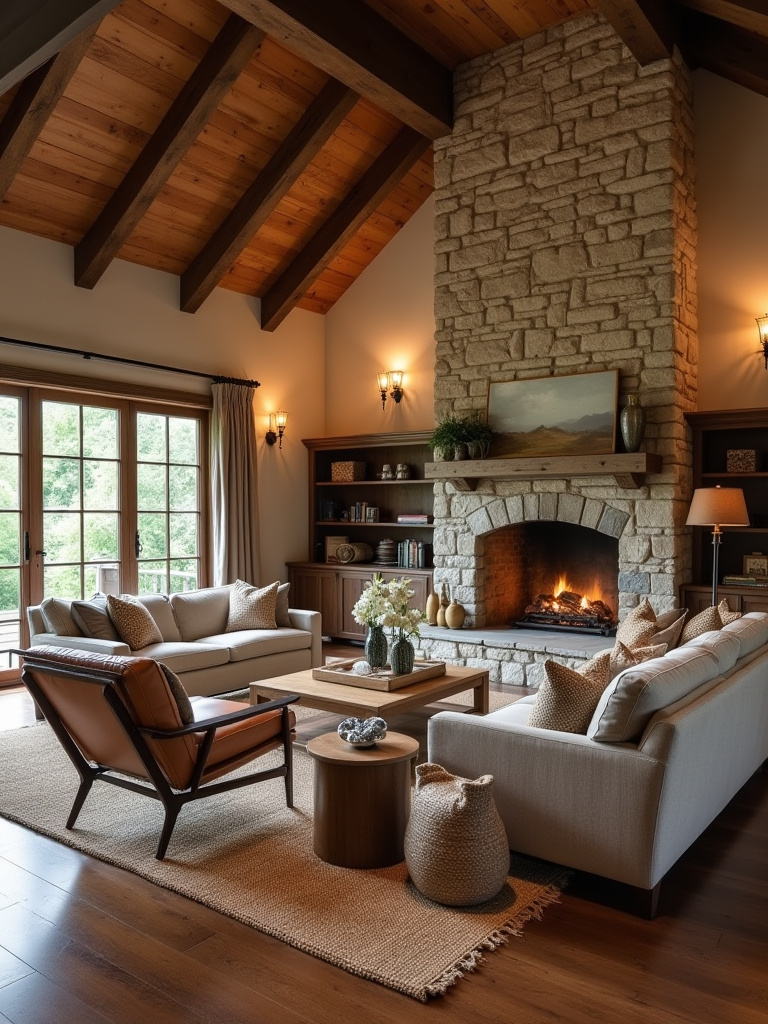
Arrange your main seating in a “U” or “L” shape around a central point, like the coffee table or rug. People should be close enough to speak without shouting—no more than 8 to 10 feet apart. In a larger room, you can create multiple zones: a main seating area by the fire, and perhaps a quiet reading nook with a single armchair and a lamp in a corner. It’s about creating destinations within the room, making every part of it usable and inviting.
And finally, the very last detail.
19. Select Rustic-Inspired Hardware to Elevate Finishes
Hardware—the handles on your cupboards, the knobs on your drawers, the hinges on your doors—is the jewellery of a room. It’s a small detail, but it has a huge impact. Swapping out cheap, generic hardware for something with a bit of weight and character is a game-changer. Think of hand-forged iron, oil-rubbed bronze, or unlacquered brass that will develop a beautiful patina over time.
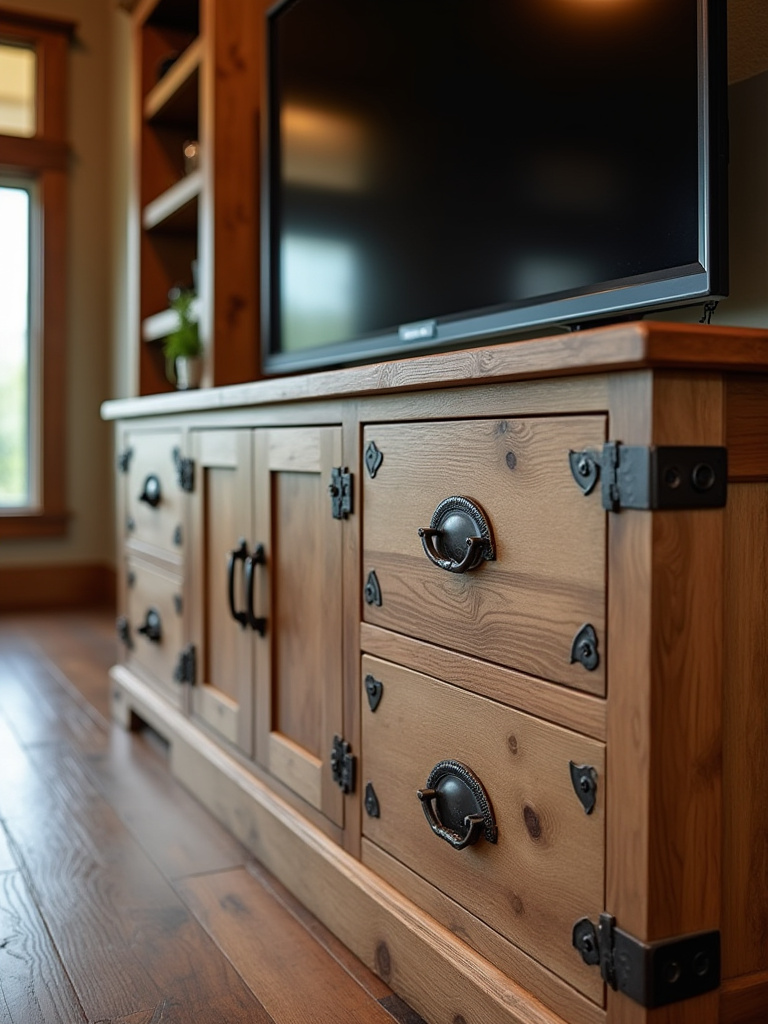
A client of mine had a perfectly nice, but rather bland, built-in cabinet. We didn’t replace the unit; we simply replaced the shiny chrome handles with heavy, hammered bronze pulls. The transformation was astonishing. The unit instantly looked more expensive, more solid, and more intentional. Don’t overlook these details. They are the touchpoints of a room, and getting them right makes a space feel considered and complete.
Crafting Your Rustic Sanctuary: It’s All in the Story
So there we have it. Creating a truly rustic living room isn’t a matter of following a formula or buying a checklist of items. It’s an attitude. It’s about prioritising the honest beauty of natural materials, the deep comfort of well-made furniture, and the unique character of things that have lived a life. It’s about building a space that feels collected, not decorated.
Don’t be afraid of a bit of wear and tear. Let the wood scratch, let the leather soften, let the brass tarnish. These are not flaws; they are the marks of a life well-lived. Your home should be a reflection of your story, a sanctuary that feels as good as it looks. So go on, start your collection, embrace imperfection, and create a room that gives you a warm, welcoming hug the moment you walk through the door.
